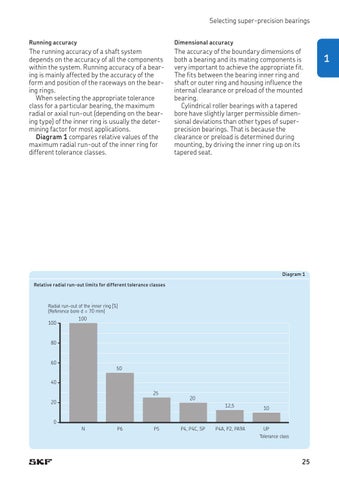Selecting super-precision bearings Running accuracy
Dimensional accuracy
The running accuracy of a shaft system depends on the accuracy of all the components within the system. Running accuracy of a bearing is mainly affected by the accuracy of the form and position of the raceways on the bearing rings. When selecting the appropriate tolerance class for a particular bearing, the maximum radial or axial run-out (depending on the bearing type) of the inner ring is usually the determining factor for most applications. Diagram 1 compares relative values of the maximum radial run-out of the inner ring for different tolerance classes.
The accuracy of the boundary dimensions of both a bearing and its mating components is very important to achieve the appropriate fit. The fits between the bearing inner ring and shaft or outer ring and housing influence the internal clearance or preload of the mounted bearing. Cylindrical roller bearings with a tapered bore have slightly larger permissible dimensional deviations than other types of superprecision bearings. That is because the 足clearance or preload is determined during mounting, by driving the inner ring up on its tapered seat.
Diagram 1 Relative radial run-out limits for different tolerance classes
Radial run-out of the inner ring [%] (Reference bore d = 70 mm) 100
100
80
60
50
40 25 20
20 12,5
10
0 N
P6
P5
P4, P4C, SP
P4A, P2, PA9A
UP Tolerance class
25
1
